Berlin, Germany, September 26th - October 3rd 1909
The first air race meeting in Germany
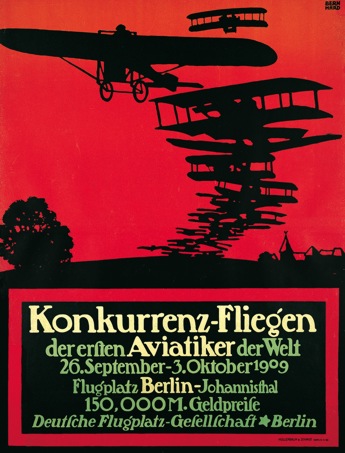
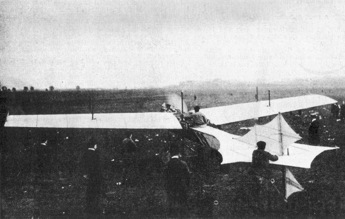
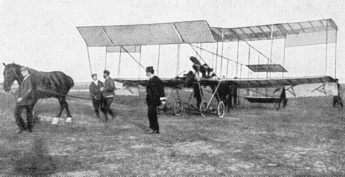
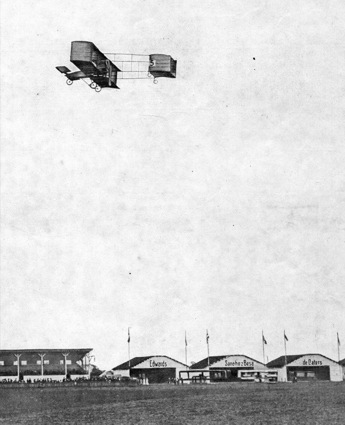
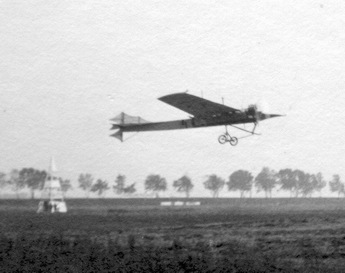
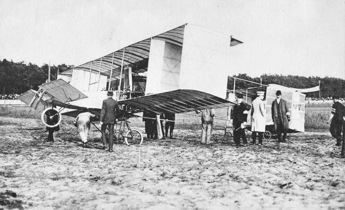
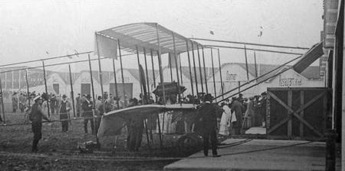

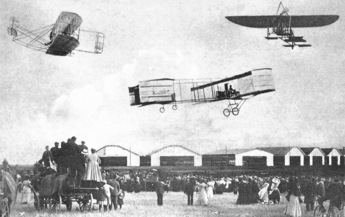
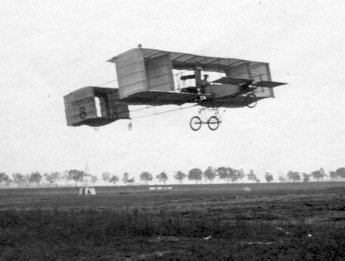
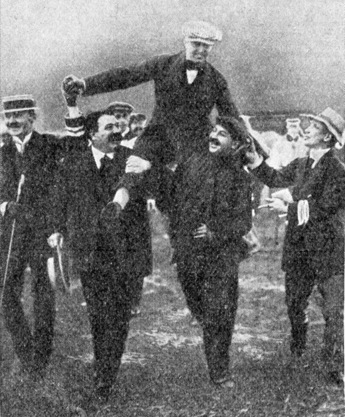
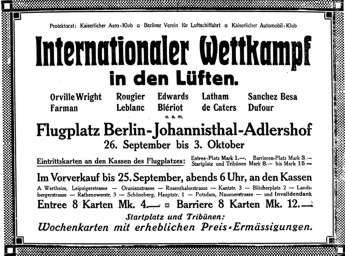
The enormous success of the Reims meeting triggered the
organisation of many similar "aviation weeks" in towns
all over Europe. Several of them didn't involve any competitive
flying, the organizers simply contracted some pilots, in a couple
of cases only one, and sold tickets. This was probably a lucrative
business, since there were many who wanted to see an airplane fly,
in many cases for the first time in their life. Already in
September and October of 1909 there were complaints in the aviation
press that there were too many meetings. There were fears that
flying would degrade to a mere spectacle for the crowds and that
there would be less opportunity for pilots and constructors to
measure themselves against others in order to further the
development of aviation. Pilots had started to request appearance
money in order to enter races, rather than competing to win prizes.
The effects of the competition between the meetings had already
been seen in Brescia, where several pilots left before the end of
the meeting. The aero clubs in different countries tried to control
the situation by limiting the number of sanctioned events.
One of the first towns to jump on the aviation week bandwagon was
Berlin, which immediately after the Reims meeting announced that
the Deutsche Flugplatz-Gesellschaft, together with the Berliner
Verein für Luftschiffahrt and the German Aero Club, would organize
a meeting on the newly constructed Johannisthal airfield between
September 26th and October 3rd. The organizers published an
impressive list of potential participants, which was later reduced,
but the starting field was nevertheless of high quality:
- Louis Blériot (Blériot)
- Pierre de Caters (Voisin)
- Hermann Dorner (Dorner)
- Emilio Edwards (Voisin)
- Henry Farman (Farman)
- Hubert Latham (Antoinette)
- Alfred Leblanc (Blériot)
- Léon Molon (Bleriot)
- Henri Rougier (Voisin)
- José Sánchez Besa (Voisin)
The meeting got off to a bad start when the opening had to be delayed by three hours because preparations were not finished. There wasn't much action on the first day. De Caters and Blériot each made a short test flight late in the afternoon, but not long enough to qualify for any of the competitive events. Farman flew two laps, barely higher than the grass. Leblanc nosed over during a test flight when he hit a hole after the landing, causing little damage to the plane and no injury to himself.
Monday September 27th
Not very much happened on the second day either, but in the afternoon Latham caused a sensation by flying into the airfield from the Tempelhof field where he had practiced and made demonstration flights the week before. The ten-kilometre flight, which was the first cross-country flight in Germany and one of the first ever over a populated area, took less than eleven minutes and was finished by a couple of circles around the airfield. After the landing Latham was congratulated by the French ambassador and the big crowds, while the orchestra played the Marseillaise. Apart from this, no flying was done until after 5 p.m., when Farman flew eight times round the course, practicing for the speed event. Blériot flew five laps. Molon, De Caters, Latham, and Sánchez Besa all made attempts, but the ground was in so bad condition that none of them could get up enough speed to lift. After them Latham tried another flight, but damaged a wing, and Blériot and Farman rounded off the day by flying a couple laps each.
Tuesday September 28th
The third day of the meeting saw a lot more flying. Farman posted the first time in the speed competition. As usual he flew very close to the ground and covered the eight laps in 22:09.4, with a fastest lap of 2:33.2. Blériot also tried, but due to engine problems he pulled out before completing the eight laps. His best lap was 2:34.2. Then Latham made a big improvement, reaching 18:46.8, with a best lap of 2:19.2. De Caters suffered engine, propeller and tyre damage after a heavy landing and withdrew for repairs. Rougier reached an altitude of 94 meters during a 53-minute 17-lap flight and took the lead in the altitude competition. The Chilean Emilio Edwards made two laps of the course in his Voisin, but then his engine stopped and he crashed into the ground from an altitude of 30 meters. His "canary yellow" plane was wrecked and Edwards was thrown out of the plane. He was at first not found by the rescuers, but miraculously escaped with only a bruised upper lip.
Wednesday September 29th
This day was also busy, and the first pilot to set a mark was Rougier, who flew 77.5 km in around 1 h 40 to take the lead in the distance competition. Latham was not far behind, flying 67.5 km in 1 h 14. Leblanc, Molon, and Sánchez Besa made several short flights during the day, and Farman made another try for the speed competition, but did not manage to improve his time from the previous day. Rougier made a flight with two passengers, who were carried twice around the track at a height of 50 feet. Mr. Latham flew about 51 1/4 miles in 1 h. 22 m.
There were two accidents. Molon crashed into a barrier just in front of the grandstands after a rapid drop of 15 meters, damaging a wing. Sánchez Besa's engine stopped, and the machine made a very heavy landing from some ten meters, breaking the landing gear and the wing centre section. Neither of the pilots was injured.
Blériot refused to fly any more, stating that the bad state of the airfield made takeoffs and landings too dangerous. The organizers tried to force him to fly. According to a local newspaper they even seized his machine for breach of contract. His partner Leblanc also refused to fly in protest over the treatment of Blériot. The arguments were obviously temporarily settled, because Blériot was allowed to leave for Cologne on the day after. However, Blériot made counter-claims, stating that he had fulfilled his contractual obligations by flying on the first two days and that organizers in fact owed him 20,000 francs, which they reputedly couldn't pay because the ticket sales during the first days had been too low. The case was finally heard in court in January 1910...
Thursday 30 September
The hero of the day was Latham, who succeeded in improving on Rougier's effort for the distance prize, flying 33 laps of the course, 82.5 km, in 1 h 22, only stopping because of the falling darkness. After landing Latham hit a lamppost, and was reportedly confronted by a policeman, who wanted to arrest him for damaging public property. The race committee eventually set matters right… Rougier took another passenger for a trip, and reached a height of 70 metres. Both de Caters and Leblanc made short flights.
Friday 1 October
Rougier took back the lead in the distance competition, flying 130 km in 2 h 41:50.0, a result that would not be beaten before the end of the meeting. Like Latham on the previous day he was only prevented from continuing by the darkness. Farman also made an attempt for the distance prize, but he could only manage 33 laps, or 82.5 km, in 1 h 30. De Caters also made a dozen laps around the course, his time for the 30 km being 33:30. At one time all the three flyers were in the air together, making it look like a real race.
Saturday 2 October
Farman made another attempt for the distance prize, but without success. After flying steadily for 1 h 03, motor troubles began to develop and he had to come down. Other than this, the afternoon crowd only got to see a couple of short flights by de Caters and Molon. Rougier had removed his engine in order to make some adjustments, and it was well after five o'clock before he was ready to take the air again. Then, after a couple of trial flights to see that everything was in order, he went up with a passenger by the name of Duray and flew five laps, 13.75 km, in 17:27. Afterwards he took up Colonel Pelle, one of the military attaches to the French Embassy, and flew him once round the track.
Sunday 3 October
Rougier made a try for the altitude prize and reached 158 m, not a world record, but good enough to win. He also made another passenger flight, during which he reached a height of 70 m and completed 30 km in 36 minutes. Farman made a last attempt to win the distance contest. He kept going for two hours and covered 110 km, which would have been good enough for second place, but one of the wings touched the ground after the first 30 kilometres and the distance covered before that incident was discounted by the referees. The officially recorded distance of 80.09 km was not sufficient to improve his position. He also made a try for the passenger prize, but only completed one of the four laps required, so Rougier was the only one to post a result in that competition. Latham's last day was a disappointment. His mechanics could not get his engine to work properly until ten minutes after the deadline. He then reached a height of 178 metres, but it was too late to count. Dorner finally tried to fly his monoplane, but without success.
Conclusion
The meeting pulled big crowds, but it was still not quite the success it might have been. One of the main complaints against the arrangements was the long distance from the railway station to the airfield, while the cheap spectator areas were so far away from the course and the grandstands that it was only possible to tell what was going on by the aid of binoculars.
The organizers became very unpopular with the flyers. Apart from the conflicts with Blériot they wanted 10,000 marks as compensation from each of Edwards and Sánchez Besa, because they didn't fulfil their contracted flights due to their crashes. The organizers also withheld Rougier's prize money, claiming that since he was the only competitor in the passenger event there had been no contest. In the end Rougier had to accept getting only a third of his prize money. The Deutsche Flugplatz-Gesellschaft owed a lot of money, and the financial issues were not solved until after a reorganization and change of management in early 1910.
National feelings were strong and the manners of the race management also irritated the French flyers. Latham is quoted as saying that "this is the last competition I shall take part in where the competitors are treated as schoolboys and ordered about by a bunch of German military officers"...
